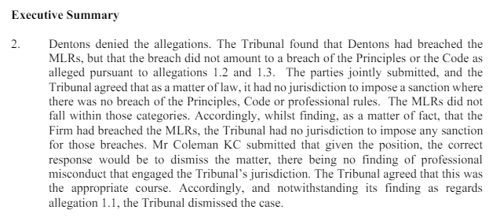
Dentons breach of AML rules was “inadvertent”……..
24/06/2024
Dentons breached Regulation 14 of the Money Laundering Regulations 2007 (the “MLRs”) by relying on what it was told by the relationship partner who had brought the client, a politically exposed person, over from Salans when it merged with Dentons in 2013.
The Tribunal found that Dentons had breached.
- Regulation 14 of the Money Laundering Regulations 2007 (the “MLRs”)
But that breaching regulation 14 on the MLR did not amount to a breach of the Principles or the Code as alleged pursuant to allegations.
- Breached all or any of Principles 6, 7 and 8 of the SRA Principles 2011 (the “Principles”);
- Failed to achieve Outcome 7.5 under the SRA Code of Conduct 2011 (“the Code”).
The result was a breach however was “inadvertent” and did not amount to professional misconduct, the Solicitors Disciplinary Tribunal (SDT) has ruled.
June 2024, 94-page ruling
- https://solicitorstribunal.org.uk/case/12476/ -
- https://solicitorstribunal.org.uk/wp-content/uploads/2023/11/12476.2023.Dentons.pdf

The SDT imposed an anonymity order in relation to ‘Client A’, even though he is easily identifiable from the facts disclosed in the ruling.
- He was chair of a bank in a high-risk non-EEA country that, during the relevant period (2013 to 2017), had internationally recognised corruption issues.
- Client A wanted to open a bank in the UK but in 2016 was convicted of fraud and embezzlement offences in his home country, imprisoned for 15 years and ordered to repay around $39m to the bank.
- His wife was made subject to the UK’s first unexplained wealth order in 2018.
- He became a client of Dentons in 2013 when it merged with Salans, whose chair François Chateau, was Client A’s relationship partner.
- Mr Chateau became global vice-chairman of the merged firm, based in its New York office. He is not qualified in England and Wales.
The Solicitors Regulation Authority (SRA) told the tribunal.
- That the firm’s general counsel had argued in 2015 that the firm should cease acting for Client A, which Mr Chateau resisted and then UK managing partner Brandon Ransley had overruled.
The SDT accepted that the firm had, “in good faith”, relied on Mr Chateau’s assertions that Client A’s wealth derived from:-
- His business activities prior to the acquisition of his shareholding in the bank, and
- Subsequently his 30% share in the bank.
“However, it was clear that Mr Chateau had failed to ask the relevant questions of Client A in order to satisfy the obligations under regulation 14:-
- “Mr Chateau did not ask Client A questions about his wealth or source of funds as
- ‘it is not the culture… because we don’t do that in Europe… this is not something we do’.”
The SDT said that, whilst it might have been plain to Mr Chateau that Client A was wealthy:-
- “this was not the same as establishing the source from which that wealth arose”.
- Equally, knowing the client was in funds “did not equate to establishing source of funds”.
- As a result, in “failing adequately (or even reasonably) to establish source of wealth”, the firm had breached regulation 14.
However, whilst the breach was “enduring”, it had been “inadvertent”, the SDT concluded:-
- “It was plain that the breach was not systemic, indeed, the firm had been commended by the SRA for its AML systems and controls.
- Those systems and controls had been deployed by the firm for each of [two property transactions under scrutiny].
- “It was clear that the firm not only had relevant and responsible AML policies in place, but that it enforced those policies.”.
This meant that the breach fell within:-
- “the small category of cases where wrongdoing did not amount to professional misconduct”.
As the breach of regulation 14 was not a stand-alone allegation of professional misconduct, the tribunal dismissed the matter.
The SRA nonetheless sought its costs – which it can do when prosecutions are properly brought even if they fail – but the SDT refused the application.
SOURCE
- https://www.legalfutures.co.uk/latest-news/dentons-breach-of-aml-rules-was-inadvertent
- The 94-page ruling https://solicitorstribunal.org.uk/case/12476/ - https://solicitorstribunal.org.uk/wp-content/uploads/2023/11/12476.2023.Dentons.pdf
- the decision announced in March https://www.legalfutures.co.uk/latest-news/sdt-clears-dentons-of-anti-money-laundering-rule-breaches
The Team
Meet the team of industry experts behind Comsure
Find out moreLatest News
Keep up to date with the very latest news from Comsure
Find out moreGallery
View our latest imagery from our news and work
Find out moreContact
Think we can help you and your business? Chat to us today
Get In TouchNews Disclaimer
As well as owning and publishing Comsure's copyrighted works, Comsure wishes to use the copyright-protected works of others. To do so, Comsure is applying for exemptions in the UK copyright law. There are certain very specific situations where Comsure is permitted to do so without seeking permission from the owner. These exemptions are in the copyright sections of the Copyright, Designs and Patents Act 1988 (as amended)[www.gov.UK/government/publications/copyright-acts-and-related-laws]. Many situations allow for Comsure to apply for exemptions. These include 1] Non-commercial research and private study, 2] Criticism, review and reporting of current events, 3] the copying of works in any medium as long as the use is to illustrate a point. 4] no posting is for commercial purposes [payment]. (for a full list of exemptions, please read here www.gov.uk/guidance/exceptions-to-copyright]. Concerning the exceptions, Comsure will acknowledge the work of the source author by providing a link to the source material. Comsure claims no ownership of non-Comsure content. The non-Comsure articles posted on the Comsure website are deemed important, relevant, and newsworthy to a Comsure audience (e.g. regulated financial services and professional firms [DNFSBs]). Comsure does not wish to take any credit for the publication, and the publication can be read in full in its original form if you click the articles link that always accompanies the news item. Also, Comsure does not seek any payment for highlighting these important articles. If you want any article removed, Comsure will automatically do so on a reasonable request if you email info@comsuregroup.com.


